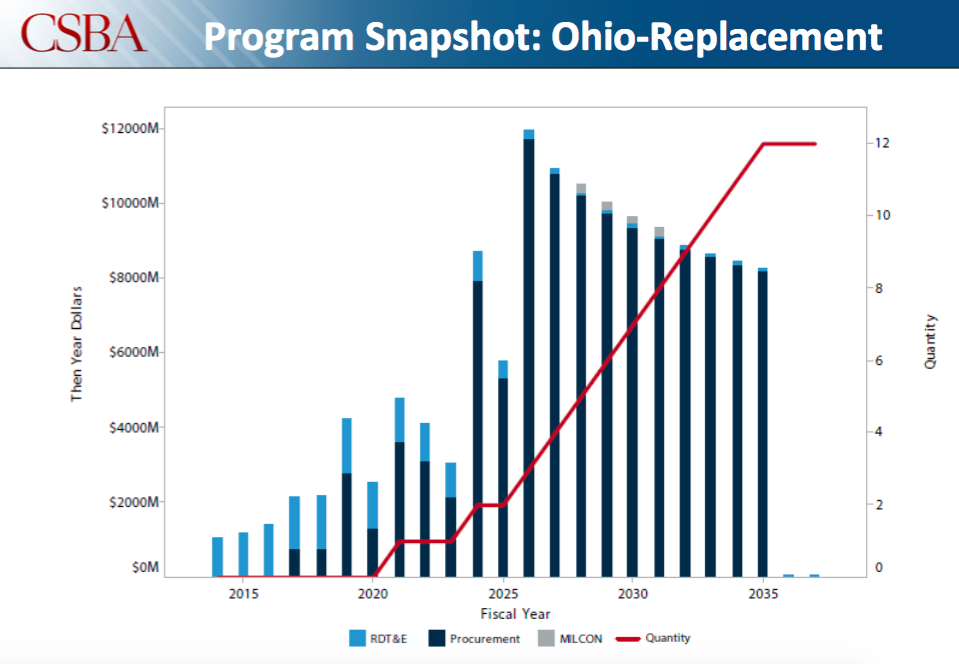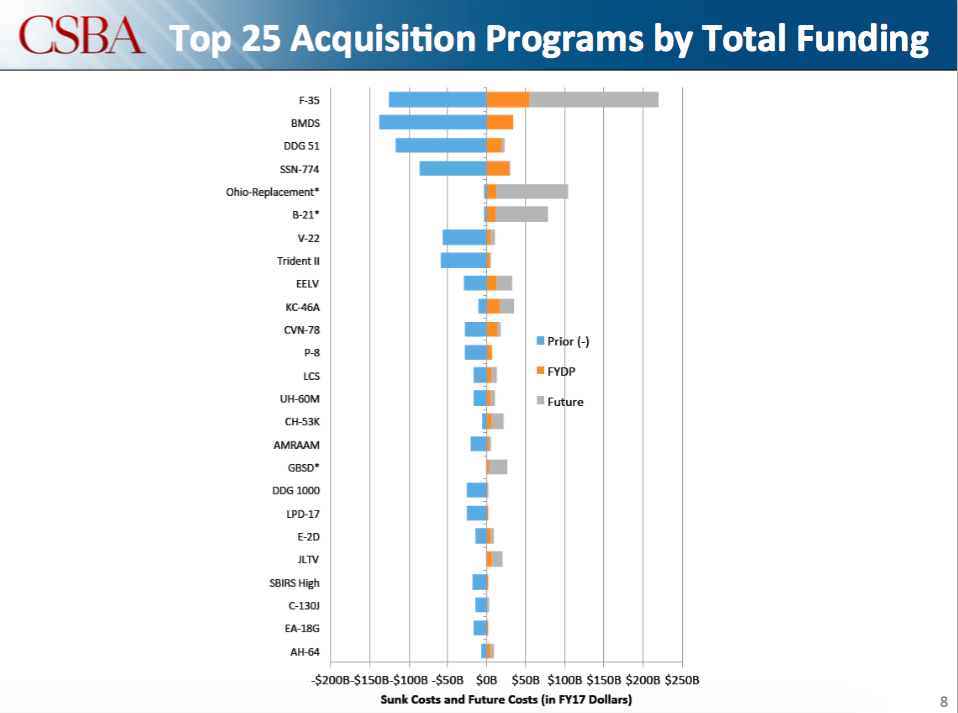Bow Wave Time Bomb: B-21, Ohio Replacement Costs Likely To Grow
Posted on

Projected costs of Ohio Replacement Program, based on official estimates — which are probably low. (CSBA)
WASHINGTON: The Pentagon is sitting on ticking fiscal time bombs: a slew of high-priority programs that are at especially high risk for cost overruns. Some particularly big-ticket programs, like the B-21 bomber and the Ohio Replacement submarine, are in the early stages of technical development, where cost growth is more likely than it is later on in actual production.
Others, like innovations associated with the Third Offset Strategy to counter Russia and China, are in areas of technology historically prone to overruns: C4ISR programs historically average 67 percent cost growth, space programs 86 percent, and drones an impressive 109 percent.
“What I’m concerned about is having a modernization bottleneck, where you end up with cost growth in one program or several… which is historically very likely… squeezing other programs (with) cascading implications,” said Katherine Blakely.

Katherine Blakeley
Blakeley and her fellow Center for Strategic & Budgetary Assessments scholar Jacob Cohn were briefing me and another reporter on their latest study, due out tomorrow. As Breaking D readers know, CSBA and other think tanks have long warned of a “bow wave” of deferred modernization spending, especially for the Air Force. Estimated costs spike just outside the five-year budget planning window like waves in front of a speeding ship. It’s less well appreciated how those estimated costs are just that, estimated, which — given the Pentagon’s track record — means they’re almost certainly underestimated. It’s even less well appreciated that many of these programs are in stages of their life-cycle or areas of technology that make them particularly prone to overruns.
The danger isn’t obvious. When you look at the Pentagon’s top 25 programs, as computed by CSBA, most of them look pretty mature, with 16 having spent more in the past than they’re estimated to in the future. The biggest program, the F-35 Joint Strike Fighter, expects future spending to outstrip past spending, but it’s still close to the halfway point and entering full-rate production, which means costs should stabilize. But a bunch of other programs have a lot of cost and a lot of uncertainty ahead.

The 25 largest defense programs. (CSBA graphic)
From biggest to smallest, we have the:
- Navy’s Ohio Replacement Program (ORP) ballistic missile submarine, which is so expensive that Congress created a controversial special fund;
- Air Force’s B-21 stealth bomber, which has extremely ambitious cost targets;
- Air Force’s space rocket for satellite launches, the troubled Evolved Expendable Launch Vehicle (EELV);
- Marine Corps’s CH-53K heavy lift helicopter;
- Air Force’s new ballistic missile, the Ground-Based Strategic Deterrent (GBSD);
- Army and Marine Corps replacement for the Humvee, the Joint Light Tactical Vehicle (JLTV); and
- Army’s AH-64E Apache Guardian attack helicopter.
JLTV and the two helicopters use relatively well-proven technology, but the others involve much more risk.

Jacob Cohn
What’s more, cautioned CSBA’s Cohn, there’s an inherent bias that lowballs the future costs. Programs that are too immature to develop a cost estimate can’t be counted, by definition, but when they do mature, they sure won’t be free.
Cost grow comes most often in the early stages of a program, said Blakeley, especially in the transition from R&D to Engineering & Manufacturing Development (EMD), when brilliant innovations have to be put together into a practical product. For various historical reasons — including past decisions to postpone programs and kick fiscal cans down the road — there are a lot of major programs currently on the cusp of that costly and risky transition.
“Most of the major-league programs are right now still in BA 4,” Blakeley said. That’s Budget Activity 4, Demonstration & Validation, the last phase before Engineering & Manufacturing Development, which is BA 5. “So we’re not seeing that transition yet,” she said, but just you wait.
Better yet, total funding for BA 5 activities drops 15.5 percent over the current five-year Future Year Defense Plan, even though BA 5 spending will probably spike just after the FYDP. The Pentagon’s top buyer, Frank Kendall, “has mentioned this as concern, that you have this BA 5 cost crunch,” Blakeley said.
What programs are particularly vulnerable? B-21 and the Ohio replacement, Blakeley said without hesitation. They’re not necessarily as risky as some other programs, she said, but they’re the largest, so that a small percentage overrun will have a big impact.
Then there are other programs that are risky not so much because of their size or stage of development, but because of the kind of technology they tackle. Unfortunately, those technologies are particularly crucial to the Pentagon, especially as it seeks to restore America’s military advantage with dramatic innovations known collectively as the Third Offset Strategy. “The types of programs we’re doing a lot of investment in — space, UAVs, C4ISR — have the highest cost growth” historically, Blakeley said.
So what’s the solution? One is outlasting the Budget Control Act, whose budget caps finally lapse in 2021. But just because it’s legal to spend more on defense doesn’t mean that future presidents and Congress will. Another is to cut costs elsewhere in the Pentagon budget, which in practice means cutting pay and compensation for military personnel — a rising but politically sacrosanct share of the budget — or reducing operations and maintenance costs — also rising, but no one is quite sure why because O&M is a fiscal maze, said Blakeley.
Kicking the can down the road is the most likely expedient, Blakeley sighed. Programs will get delayed, stretched out, and spread thin, reducing production rates but increasing cost per weapon because of the inefficiencies involved.
“The game changer that’s on the horizon,” she added, “is a much closer integration of low cost platforms into the fleets”: If you augment fighters and helicopters with swarms of (relatively) cheap drones, ships and submarines with cheap unmanned surface and underwater vehicles, and so on, you could have a large force mostly made up of small, inexpensive, and even expendable parts, without so many large, expensive manned platforms.
“That’s kind of the biggest variable,” Blakeley cautioned. “It’s hard to say now, while everything in kind of in the white board concept stage, what that would do to drive procurement decisions.”
Subscribe to our newsletter
Promotions, new products and sales. Directly to your inbox.
